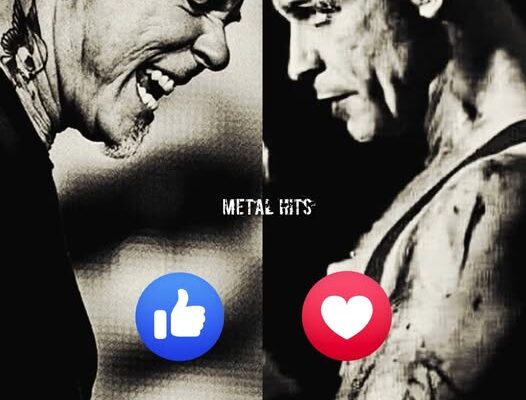James Hetfield vs. Till Lindemann – Who Truly Stands as the Ultimate Iconic Frontman in Metal?.
In the vast and uncompromising world of heavy metal, frontmen have always carried a unique burden. They are not only the faces of their bands but also the conduits through which raw power, aggression, and charisma flow. Among the countless figures who have taken on this role, two names emerge with unmatched prominence: James Hetfield of Metallica and Till Lindemann of Rammstein. Both men symbolize more than just their bands—they embody eras, styles, and philosophies of metal itself. The question of who reigns supreme as the genre’s most iconic frontman inevitably sparks debate, yet it is precisely this tension that highlights how their impact transcends music and moves into the realm of cultural legacy.
James Hetfield’s story is inseparable from the rise of thrash metal in the 1980s. As Metallica carved its path out of the Bay Area, Hetfield’s growling vocals and machine-gun rhythm guitar playing helped define the sonic template for an entire subgenre. His presence on stage is less about theatricality and more about sheer force. The way Hetfield commands audiences—through his trademark bark, his down-picked riffs, and his ability to drive momentum—makes him one of the most technically and emotionally powerful frontmen in rock history. His cries of “Yeah!” and “Are you alive?” are not just throwaway lines; they are battle calls that ignite stadiums of tens of thousands into unified chaos. Beyond performance, Hetfield is also a storyteller. His lyrics, often exploring themes of alienation, addiction, and personal struggle, have given voice to generations of listeners who find catharsis in his words. His role as a frontman goes beyond entertainment—he offers a mirror to pain and resilience.
In contrast, Till Lindemann brings an entirely different approach to the idea of a frontman. Where Hetfield embodies raw, stripped-down aggression, Lindemann transforms the stage into a living, breathing theater of shock and spectacle. As the towering leader of Rammstein, he has mastered the art of fusing music with visual provocation. His baritone voice, deep and commanding, is instantly recognizable and adds a sinister weight to the band’s industrial sound. But it is his stage persona that elevates him to iconic status. Pyrotechnics, controversial costumes, provocative stunts—these are Lindemann’s tools to captivate and unsettle his audience. Where Hetfield thrives on the collective energy of a metal crowd, Lindemann thrives on confrontation, pushing audiences to question their boundaries and comfort zones. His presence is almost operatic, combining menace, humor, and eroticism in ways few frontmen dare.
Comparing Hetfield and Lindemann is not simply about contrasting styles; it is about exploring two philosophies of performance. Hetfield represents authenticity in its purest form. He steps onto the stage as himself—flawed, scarred, yet determined—and through his music channels something deeply human. His power lies in his ability to connect with people on a visceral level, to make them feel their struggles are shared. Lindemann, on the other hand, represents transformation. He becomes larger than life, crafting characters and scenarios that are at times grotesque, at times absurd, but always captivating. His power lies in his ability to create spectacle that transcends music and enters cultural commentary. Both men, in their own ways, embody the primal essence of metal: intensity, rebellion, and catharsis.
Metallica’s global dominance over four decades is in no small part due to Hetfield’s leadership. Even after tragedies such as the death of bassist Cliff Burton and the near-collapse of the band during Hetfield’s battle with addiction, his resilience kept Metallica not only alive but thriving. His voice, though weathered by years of touring, still carries the same bite that fueled albums like Master of Puppets and The Black Album. For many, Hetfield is the archetype of the metal frontman: leather-clad, guitar in hand, commanding arenas without needing fire or theatrics. His authenticity is his spectacle. When Metallica headlines festivals, Hetfield does not need to shock the audience—his very presence is enough to electrify them.
Lindemann, in turn, has made Rammstein one of the most unique live acts in the world. Their concerts are not just performances but full-scale productions that rival Broadway or Hollywood. Lindemann’s penchant for fire breathing, controversial imagery, and theatrical delivery has earned Rammstein both adoration and controversy. Yet, it is this very fearlessness that cements his status. He challenges not just musical norms but societal taboos, addressing themes of politics, sexuality, and identity in ways that are often uncomfortable but impossible to ignore. His willingness to push boundaries makes him a frontman whose impact stretches beyond fans of metal and into mainstream cultural discourse.
When debating who reigns supreme as the most iconic frontman, one must consider influence. Hetfield’s influence on metal is foundational. He helped shape an entire genre and inspired countless musicians who followed. His riffs and stage presence are studied by aspiring guitarists and vocalists alike, and his legacy is inseparable from the DNA of modern metal. Lindemann’s influence, meanwhile, lies in reimagining what a frontman could be. He took the metal stage and turned it into a canvas for performance art, blending music with shocking visuals in a way that influenced not just bands but the entire live music industry. Both men have defined new standards of what it means to be a leader in heavy music, though they did so from different angles.
Cultural context also plays a key role. Hetfield emerged from America’s working-class rock culture, his music echoing the anxieties of disaffected youth in the 1980s. Lindemann, hailing from East Germany, brings with him a unique perspective shaped by political division, censorship, and cultural repression. His performances often bear the imprint of this history, making Rammstein’s art deeply European in its sensibility. Thus, Hetfield and Lindemann represent not just different styles of frontmanship but different cultural lineages of metal itself. Their artistry reflects their backgrounds, and their audiences respond accordingly—Hetfield as the voice of rebellion against internal demons, Lindemann as the provocateur tearing down external boundaries.
Ultimately, the question of supremacy between Hetfield and Lindemann may never have a definitive answer, because each embodies a different form of iconography. Hetfield reigns supreme as the traditional, archetypal metal frontman whose authenticity and musicianship define the genre’s core spirit. Lindemann reigns supreme as the revolutionary showman, who redefined the possibilities of stage performance and dared to make metal not just sound but spectacle. Both men are icons not because they compete in the same arena, but because they dominate their own.
In the end, perhaps the true answer is that metal needs both figures to be whole. Hetfield represents the heart and soul of metal—raw, authentic, and unfiltered. Lindemann represents its theatrical mind—provocative, boundary-pushing, and daring. Together, they illustrate the duality of the genre itself: music that can be both brutally honest and shockingly surreal. Whether one crowns Hetfield or Lindemann as the supreme frontman may depend less on objectivity and more on personal taste, but what is undeniable is that both men have carved legacies that will endure for generations. Their reigns, though different in style and execution, are equally vital to the story of heavy metal, and their names will forever stand as pillars in the pantheon of rock and roll history.



